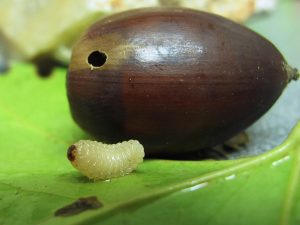
Acorn weevils (Curculio glandium) are adorable beetles found all over the United States, Canada, Mexico, and Europe; however, they are most abundant in the Eastern states due to their affinity for Oak and Hickory trees that flourish in this specific region of the U.S. If you can believe it, the long probe attached to their head is actually an extension of their mouths! Try imagining it like a long snout or beak! In the middle of this snout, Acorn Weevils have antennae coming off on either side. These antennae are elbowed, or hinged, making them look like football uprights. When the Acorn Weevil is drilling into the acorn with their long mouthpart, the antenna fold back along the side of the head. That is some great flexibility! The jaws and mouth of the Acorn Weevil are located at the very front of their snout. This allows the Acorn Weevil to chew food that is relatively far away from the rest of their body, and allows them to feed on seeds, leaves, stems, flowers, and fruits that are only made accessible to them due to their long mouth. Although Acorn Weevils can feed on other foods, they tend to stick to acorns. This is partially due to the fact that the mouth of the Acorn Weevil evolved specifically for the acorns of an Oak tree, making Acorn Weevils one of the most highly specialized species in the world! Not only do Acorn Weevil mouths look cool, but they make practical use of them too. Feeding on acorns can be difficult but the Weevils’ snouts allow them to excavate the inside of acorns to feed themselves. Acorn Weevils also have feet with two lobes that help them get a grip on the side of the smooth and slippery acorn. Unfortunately, due to the insects taste for acorns, they have become a pest for oak tree expansion. By eating the inside of acorns and using acorns to foster their eggs as they develop, the weevils kill acorns that would typically develop into large oak trees!

Similar to other insects, the Acorn Weevil can go years before indulging on tasty, liquid fat from inside acorns. Sometimes they have to wait up to three years before eating, imagine that! Although females and males both have the long characteristic snouts of Acorn Weevils, females’ tend to be longer than males, sorry boys! The reason for this unequal development is that females do not exclusively use their long mouths to feed on acorn fats, but she also uses it to bore holes into acorns so she can insert her ovipositor, a tube female insects use to lay their eggs, and lay her eggs too. Females typically lay their eggs in immature or damaged acorns during the summer allowing their eggs plenty of time to feed on the acorns and develop into squishy, white larvae by the time the acorn drops to the ground in the fall. When the acorn hits the ground, a three-day process is initiated where the larvae try to escape out of the acorn. In order to get out, the larvae push their squishy bodies out of a tunnel they dig for themselves to escape the hole that their mother left in the acorn. The hole is only about the size of their head and had been covered by the poop of their mother, yuck! Imagine trying to squeeze through a hole the size of your head, your body would have to be really squishy and flexible. Once the squishy little larvae escape the acorn, they fall onto the ground where they must wiggle and squirm their legless bodies to the soil while trying to avoid predators. This drama-filled and suspenseful feat includes dodging shrews, other rodents and insects that feed on plump weevil larvae. If the larvae reach the soil and are able to bury into it unscathed, then they will stay there as they pupate for 1 or 2 years undergoing metamorphosis, a process where insects mature from an immature stage to their adult stage (basically like a more intense puberty, yikes!), before emerging as an adult. Once reaching adulthood these little weevils will live for another 2 to 3 years.

If you haven’t already, check out this video of Entomologist George McGavin taking a look at the Acorn Weevil, he thinks they’re as cool as we do!
Hi there, I simply couldn’t leave your website without saying that I appreciate the information you supply to your visitors. Here’s mine YW9 and I cover the same topic you might want to get some insights about Airport Transfer.